Swimming Styles and Their Benefits
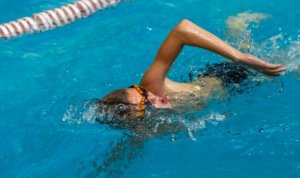
Swimming is a very complete sport, besides being good for our health and advisable for many ailments. This sport has multiple swimming styles and their benefits can be found in all its styles: front crawl, backstroke, breaststroke, and butterfly.
Multiple swimming styles and their benefits
Front Crawl
This is the most popular of the multiple swimming styles, it originated in Australia. In competitions, it’s known as freestyle.
To practice a good front crawl, the objective is to achieve a good prone position advancing by moving your arms in an alternate way, similar to a windmills’ blades. Moreover, you need to breathe while you’re on your side and kicking your legs.
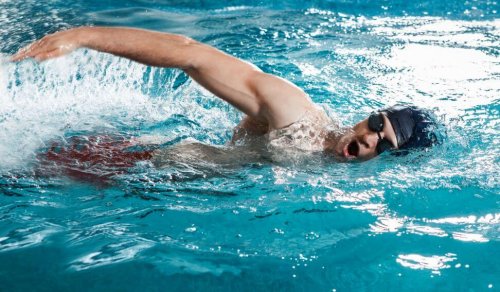
Swimming is one of the most recommended sports for people with back problems.
Backstroke is one of the multiple swimming styles with many benefits
This style is known as “back crawl”. Its main characteristic is that you swim backward on your back, besides its particular shoulder swing. Leg movements in backstroke are known as backbeat or dorsal beat. Backstroke is the most recommended of the multiple swimming styles for older people who have back, neck or spinal cord issues. It’s the third fastest swimming style.
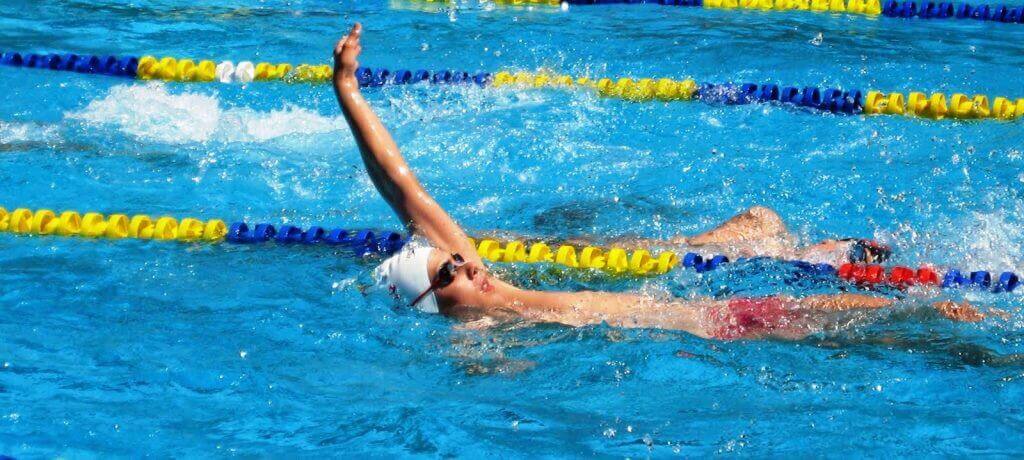
Breaststroke: a swimming style with many benefits
As we have said before, this is the slowest out of the multiple swimming styles. The benefits are found in the distinctive characteristic of how the arms and legs push: arms and legs split the thrust evenly.
Swimming in a prone position, the swimmer alternates arm strokes and leg strokes. Shoulders and hips perform an up and down movement, added to the coordinated arm stroke.
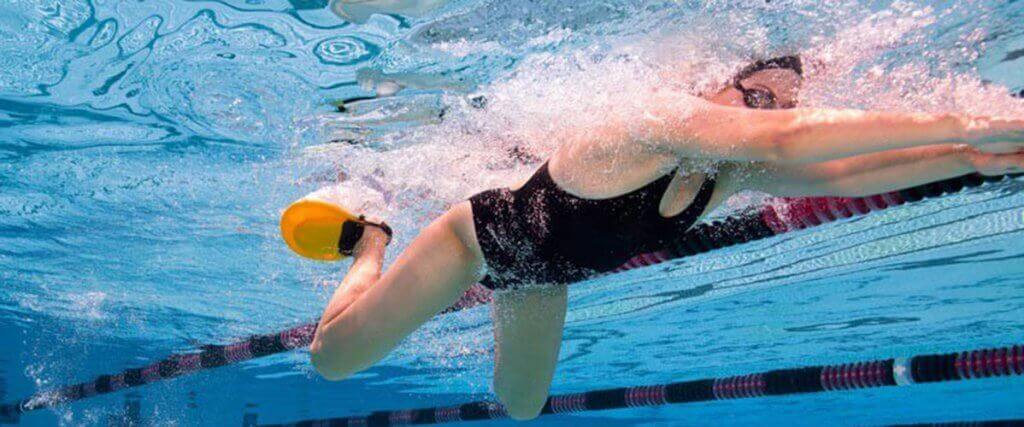
Butterfly
Butterfly style is the most modern of all. It’s a variation of the breaststroke, with one of its special characteristics being a constant movement of the whole body, forming an “S”. In order to achieve a stronger thrust in the water, arms and legs must be perfectly coordinated.
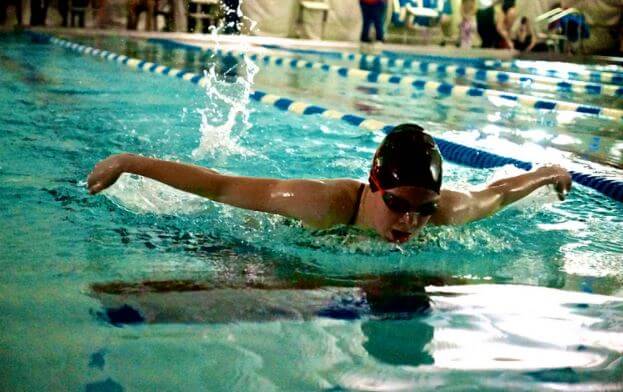
Benefits of multiple swimming styles
Burning fat
Swimming is a good exercise for people who have weight loss among their goals, depending on the intensity and the swimming style, you can burn between 500 to 600 calories per hour.
Cardiorespiratory benefits
The heart can increase blood circulation by up to 18 percent since swimming improves oxygen consumption. This decreases heart rate, while increasing cardiorespiratory endurance.
Improve chronic diseases
When you practice a low intensity aerobic exercise during longer sessions, you decrease blood sugar levels, This makes your body more sensitive to insulin and decreases blood sugar levels (diabetes).
Increased flexibility and elasticity
When we swim we use most of our body muscles, (upper and lower body), besides the torso and head. This is the reason why our joints’ flexibility is increased. Muscles become stronger and more toned, especially our back muscles. This makes it a recommended exercise for people who suffer from hernias, lumbago and hip problems.

Low impact on bones and joints
When we submerge our bodies into the water for sporting purposes, we weigh less. The body doesn’t impact the ground or hard surfaces as with many other sports. In this instance, your joints suffer less wear.
Swimming, in any of its styles, is definitely recommended. It provides us with health benefits and helps to lower our stress levels.
Swimming is a very complete sport, besides being good for our health and advisable for many ailments. This sport has multiple swimming styles and their benefits can be found in all its styles: front crawl, backstroke, breaststroke, and butterfly.
Multiple swimming styles and their benefits
Front Crawl
This is the most popular of the multiple swimming styles, it originated in Australia. In competitions, it’s known as freestyle.
To practice a good front crawl, the objective is to achieve a good prone position advancing by moving your arms in an alternate way, similar to a windmills’ blades. Moreover, you need to breathe while you’re on your side and kicking your legs.

Swimming is one of the most recommended sports for people with back problems.
Backstroke is one of the multiple swimming styles with many benefits
This style is known as “back crawl”. Its main characteristic is that you swim backward on your back, besides its particular shoulder swing. Leg movements in backstroke are known as backbeat or dorsal beat. Backstroke is the most recommended of the multiple swimming styles for older people who have back, neck or spinal cord issues. It’s the third fastest swimming style.

Breaststroke: a swimming style with many benefits
As we have said before, this is the slowest out of the multiple swimming styles. The benefits are found in the distinctive characteristic of how the arms and legs push: arms and legs split the thrust evenly.
Swimming in a prone position, the swimmer alternates arm strokes and leg strokes. Shoulders and hips perform an up and down movement, added to the coordinated arm stroke.

Butterfly
Butterfly style is the most modern of all. It’s a variation of the breaststroke, with one of its special characteristics being a constant movement of the whole body, forming an “S”. In order to achieve a stronger thrust in the water, arms and legs must be perfectly coordinated.

Benefits of multiple swimming styles
Burning fat
Swimming is a good exercise for people who have weight loss among their goals, depending on the intensity and the swimming style, you can burn between 500 to 600 calories per hour.
Cardiorespiratory benefits
The heart can increase blood circulation by up to 18 percent since swimming improves oxygen consumption. This decreases heart rate, while increasing cardiorespiratory endurance.
Improve chronic diseases
When you practice a low intensity aerobic exercise during longer sessions, you decrease blood sugar levels, This makes your body more sensitive to insulin and decreases blood sugar levels (diabetes).
Increased flexibility and elasticity
When we swim we use most of our body muscles, (upper and lower body), besides the torso and head. This is the reason why our joints’ flexibility is increased. Muscles become stronger and more toned, especially our back muscles. This makes it a recommended exercise for people who suffer from hernias, lumbago and hip problems.

Low impact on bones and joints
When we submerge our bodies into the water for sporting purposes, we weigh less. The body doesn’t impact the ground or hard surfaces as with many other sports. In this instance, your joints suffer less wear.
Swimming, in any of its styles, is definitely recommended. It provides us with health benefits and helps to lower our stress levels.
All cited sources were thoroughly reviewed by our team to ensure their quality, reliability, currency, and validity. The bibliography of this article was considered reliable and of academic or scientific accuracy.
- Williams, T. M. (2009). Swimming. In Encyclopedia of Marine Mammals. https://doi.org/10.1016/B978-0-12-373553-9.00262-5
- Toussaint, H. M., & Beek, P. J. (1992). Biomechanics of Competitive Front Crawl Swimming. Sports Medicine: An International Journal of Applied Medicine and Science in Sport and Exercise. https://doi.org/10.2165/00007256-199213010-00002
- Holmér, I. (1974). Energy cost of arm stroke, leg kick, and the whole stroke in competitive swimming styles. European Journal of Applied Physiology and Occupational Physiology. https://doi.org/10.1007/BF00449512
- Takahashi, H., Nakai, K., Ezaki, N., Omae, Y., Kon, Y., Sakurai, Y., … Miyaji, C. (2015). Toward classification of swimming style by using underwater wireless accelerometer data. https://doi.org/10.1145/2800835.2800875
This text is provided for informational purposes only and does not replace consultation with a professional. If in doubt, consult your specialist.








